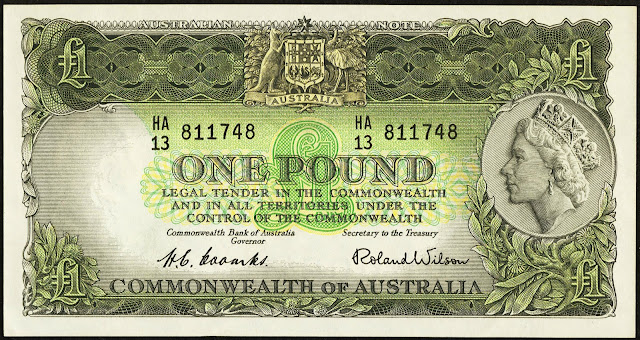Commonwealth of Australia One Pound banknote 1953 Queen Elizabeth II
Commonwealth Bank of Australia 1953-1960 Issue
Last Australian One Pound Predecimal Banknote 1953-1965
Obverse: Image of a plaster cast of Queen Elizabeth II in profile, by sculptor W. L. Bowles. At the top is the Coat of arms of Australia, the center shows the serial number, and detail over one pound (symbol) on a design background, with signatories below. The nominal value £1 in each corner of the banknote.
Signatories: H. C. Coombs, Governor, Commonwealth Bank of Australia & Roland Wilson, Secretary to the Treasury.
Reverse: Explorers Charles Sturt and Hamilton Hume were represented, in a coin-shaped format.
Watermark: Captain James Cook in left oval, "ONE POUND" behind each signature.
Size: 156 mm × 81 mm.
Sturt, who arrived in Sydney in 1827, explored the western areas of New South Wales. The Darling River was discovered and the Macquarie, Murray and Murrumbidgee river systems explored. Later explorations took him as far inland as the Simpson Desert, South Australia.
Hume explored the southern districts of New South Wales and, with William Hovell, travelled overland to Corio Bay (Port Phillip). He accompanied Sturt on the expedition that discovered the Darling River. The Murray River was once called the Hume River in his honour.
Australian banknotes - Australia paper money
Commonwealth Bank of Australia, 1953-1960 Issue
10 Shillings One Pound 5 Pounds 10 Pounds
Reserve Bank of Australia, 1961-1965 Issue
10 Shillings One Pound 5 Pounds 10 Pounds
Charles Sturt
Captain Charles Napier Sturt (born 28 April 1795, Bengal, India — died June 16 June 1869, Cheltenham, Gloucestershire, England), was a British explorer of Australia whose expedition down the Murrumbidgee and Murray rivers (1829–30) is considered one of the greatest explorations in Australian history. The expedition disclosed extensive areas of land for future development in New South Wales and South Australia. He led several expeditions into the interior of the continent, starting from both Sydney and later from Adelaide. His expeditions traced several of the westward-flowing rivers, establishing that they all merged into the Murray River. He was searching to determine if there was an "inland sea".
Educated in England, Sturt entered the British army at the age of 18 and for the next 13 years saw service in Spain, Canada, France, and Ireland. In 1827 he became military secretary to the governor of New South Wales, Sir Ralph Darling. In 1828–29 Sturt led the first of his major expeditions, tracing the Macquarie, Bogan, and Castlereagh rivers and discovering the Darling River. In his subsequent expedition down the Murrumbidgee, he discovered the Murray River and followed it to its mouth near Adelaide, dealing peaceably with many Aborigines along the way. Exhausted and nearly blinded because of poor diet and overexertion on his trip, he spent 1832–34 recuperating in England, where he wrote Two Expeditions into the Interior of Southern Australia, 1828–31 (1833). The book led to the choice of South Australia as the site for a new British settlement.
Sturt returned to Australia in 1835 with a 5,000-acre (2,000-hectare) grant of land and later (1844–46) led an expedition north from Adelaide to the edge of the Simpson Desert. Although it discovered no fertile land and was eventually driven back by heat and scurvy, his party was the first to penetrate the centre of the continent. After serving briefly as registrar general and colonial treasurer, he again left Australia for England (1847), where he wrote Narrative of an Expedition into Central Australia (1849). He settled in England permanently in 1853. In New South Wales, Sturt National Park, which encompasses some 1,200 square miles (3,100 square km), commemorates his achievements.
Hamilton Hume
Hamilton Hume, in full Andrew Hamilton Hume (born June 19, 1797, near Parramatta, New South Wales, Australia—died April 19, 1873, Coomer Cottage, Yass, New South Wales), Australian explorer whose work did much to open up the Berrima–Bong Bong district.
Hume was the eldest son of Andrew Hamilton Hume (1762–1849), a farmer and a superintendent of convicts. The son began exploring at the age of 17 with his brother John and an Aboriginal and extended his range (1814–15). He travelled with Charles Throsby and James Meehan (1818), accompanied John Oxley and Meehan to Port Jervis (1819), and with others discovered the Yass Plains (1822).
Unable to get financial support from the government for an overland expedition to the southern coast of Australia, Hume accepted that of William Hovell, a sailor whose inexperience in the bush was compensated by his skill at navigation. They traversed from Gunning to Corio Bay (October 1824–January 1825), discovering part of the Murray River and valuable farming and grazing lands. For this journey Hume was rewarded by a grant of 500 acres (200 hectares) on the Crookhaven River.
In 1828 Hume accompanied Charles Sturt on an expedition that discovered Darling River, but as a result his health was broken, and he settled on the Yass Plains, where he was granted 500 acres by Governor Darling.
When in 1853 Hovell visited Geelong, established after his and Hume’s 1824–25 exploration, and was celebrated as its discoverer, Hume wrote A Brief Statement of Facts in Connection with an Overland Journey from Lake George to Port Phillip (1855) to redress what he considered a slight. Hovell published A Reply (1855), and their friendship ended.
In 1860 Hume was elected a fellow of the Royal Geographical Society, and later he served as magistrate until his death.

